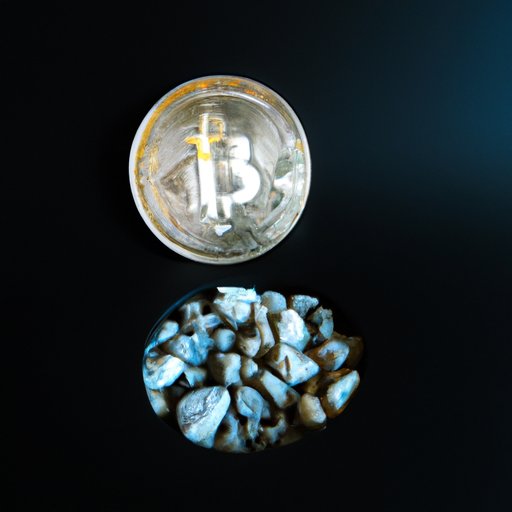
I. Introduction
Bitcoin is a digital currency that has been gaining popularity and acceptance worldwide. It allows users to transact without intermediaries, making it a decentralized and borderless form of payment. It’s no surprise that many people are interested in acquiring bitcoins for various reasons such as investment, trading, and online purchases. In this article, we will explore different methods on how to get bitcoins, their benefits, risks, and how you can get started today.

II. Buying Bitcoins: A Comprehensive Guide for Beginners
One of the easiest ways to get bitcoins is by purchasing them through an exchange or a peer-to-peer marketplace. Exchanges allow you to buy and sell bitcoins for traditional currencies, while peer-to-peer marketplaces allow you to buy and sell directly with other users. When choosing an exchange or marketplace, it’s important to consider factors such as reputation, fees, and security.
To buy bitcoins, you’ll need to set up a wallet to store them first, and then choose a payment method such as credit card, bank transfer, or PayPal. Once you’ve purchased your bitcoins, it’s important to keep them safe by securing your wallet and enabling two-factor authentication. Remember to only buy as much as you can afford to lose and never rely on a single source of information or analysis.
III. Earning Bitcoins: 5 Legit Ways to Get Free Bitcoins Fast
Earning free bitcoins is possible through legitimate means, although it may not make you rich overnight. Faucets, microtask websites, freelancing, mining, and trading are some examples of ways on how to earn bitcoins without spending money. Faucets offer small amounts of bitcoins for completing captcha or surveys, while microtask websites pay for completing small tasks or offers. Freelancing allows you to earn bitcoins by offering your skills and services to clients who pay in bitcoins. Mining and trading, on the other hand, require more technical skills and investment but can potentially yield higher profits in the long run.
Before choosing a method, it’s important to consider its pros and cons, such as earning potential, time commitment, and risks. Some methods may be more sustainable or profitable than others depending on your experience, preferences, and goals. You can further maximize your earnings by using multiple methods and avoiding scams or fraudulent schemes.
IV. Bitcoin Mining: What It Is and How to Start Mining Bitcoins
Mining is the process of validating transactions and adding them to the Bitcoin blockchain, which is rewarded with new bitcoins. While it used to be profitable and accessible for individual miners, it has become increasingly difficult and expensive due to the rise of specialized hardware and competition. There are different mining methods, such as solo mining, pool mining, and cloud mining, each with their own advantages and disadvantages.
If you’re interested in mining bitcoins, you’ll need to invest in a mining rig that consists of hardware components such as ASICs, GPUs, and power supply. You’ll also need to set up a mining software and join a mining pool to increase your chances of earning bitcoins. Remember that mining requires a high level of technical knowledge, electricity, and maintenance costs, and that its profitability and sustainability depend on market conditions, difficulty level, and network hash rate.
V. Trading Bitcoins: A Beginner’s Guide to Bitcoin Trading
Trading is the act of buying and selling bitcoins on different platforms, such as centralized exchanges, decentralized exchanges, and peer-to-peer marketplaces, with the aim of making a profit from the price difference. It requires knowledge of technical and fundamental analysis, trading psychology, and risk management. There are different trading strategies, such as scalping, day trading, and swing trading, each with their own strengths and weaknesses.
Before starting to trade, you’ll need to choose a reputable trading platform that suits your needs and preferences, such as ease of use, security, and fees. You’ll also need to create a trading plan and stick to it by setting your entry, exit, and stop-loss points. Remember to always stay up-to-date with the market news and trends and never invest more than you can afford to lose.
VI. Investing in Bitcoins: How to Safely Invest in Bitcoin for the Long Term
Investing is the act of holding bitcoins for a long period of time, usually years, with the expectation that its value will increase over time due to its limited supply, adoption, and utility. There are different investment strategies, such as HODLing (holding on for dear life) and dollar-cost averaging, each with their own advantages and disadvantages.
Before investing in bitcoins, it’s important to consider factors such as its volatility, regulation, and competition, and to diversify your portfolio in case of market fluctuations. You can invest in bitcoins directly by buying them and storing them in a secure wallet, or indirectly by investing in Bitcoin-related companies or funds. Remember to always do your own research and seek professional advice before making any investment decisions.
VII. Accepting Bitcoins: A Guide to Accepting Bitcoin Payments for Your Business
If you’re a business owner, you can also accept bitcoins as a form of payment from your customers, as it offers lower transaction fees, faster settlements, and greater privacy compared to traditional payment methods. To accept bitcoins, you’ll need to set up a merchant account with a payment processor that converts bitcoins into traditional currencies or holds them in your wallet.
Some benefits of accepting bitcoins include reaching a wider audience, being seen as an innovative and tech-savvy business, and hedging against fiat currency devaluation. However, there are also risks of volatility, regulatory uncertainty, and technical glitches that you should be aware of. To mitigate these risks, you can set a fixed price in bitcoins, use a third-party escrow service, and follow taxation and accounting rules.
VIII. Bitcoin Faucets: What Are They and How to Use Them to Get Free Bitcoins
Bitcoin faucets are websites or apps that give away small amounts of bitcoins for free in exchange for completing simple tasks, playing games, or spinning a wheel. While they may seem too good to be true, many faucets are legitimate and offer a small but consistent way of earning bitcoins without investing any money.
Some faucets require you to reach a certain threshold before withdrawing your earnings, while others pay directly to your wallet or offer referral bonuses. However, some faucets are also scams or fraudulent, so it’s important to do your own research and avoid clicking on suspicious links or downloads.
IX. Conclusion
In conclusion, getting bitcoins is not as complicated as it may seem, but it requires some knowledge, skills, and precautions. Whether you choose to buy, earn, mine, trade, invest, or accept bitcoins, there are different methods that suit your needs and preferences. By following our comprehensive guide for beginners, you can acquire and manage your bitcoins safely and efficiently. Remember to keep learning, keep experimenting, and keep hodling.




